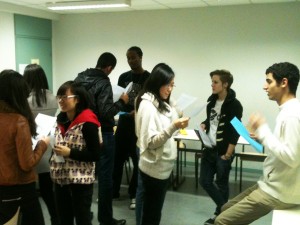Blended learning : méthode d’apprentissage
In a blended approach, e-learning sessions can be integrated with face-to-face (F2F) traditional activities using a variety of approaches. Blended learning combines different training media (e.g. e-learning technologies, activities and events) to create an optimum training programme for a specific audience. The term “blended” means that traditional instructor‑led training (F2F) is being supplemented with electronic formats (e-learning modules) that can be worked on independently and video conferences (events) which do not require the physical presence of the trainees.
E-learning and (virtual) classroom training
E-learning is a convenient option for organizations in certain situations (e.g. when there is a need to reach many geographically dispersed learners). In a self-paced e-learning course, learners can study course materials at any time they wish. This requires that learners have access to a set of interactive and self-contained materials. Facilitated or instructor‑led e-learning (synchronous teaching) takes place at a specific time and usually integrates self-study with collaborative activities such as discussions or group work.
The programme flow model
The programme flow model in blended learning is suited for observable outcomes and assessment purposes (including certification like Cambridge Certificates and Bulats), since it enables formal tracking of learners’ progress. Each step can be easily monitored by the instructors.

The core-and-spoke model
Another approach consists of starting with a core classroom event, followed by online independent experiences which can include, for example, interaction with online resources or e-mentoring services for continuous reinforcement. This approach could be used to develop communities of learners or to engage in further discussions on advanced topics of individual interest.
Classroom training (F2F) complementary to e-learning
Classroom training has changed significantly throughout the last 2 decades. Once being the typical training that we all know and are used to, with a combination of lectures and hands-on exercises it has developed into interactive teaching by the means of cooperative learning strategies, putting the learner in the focus of teaching. Care should be taken to have a balance of approx. 20/80 in respectively lectures and hands-on components. Participants learn much more by doing things themselves, as opposed to listen to a lecturer. The absorption level of lectures drop rapidly after 15 minutes, and the duration of lectures should therefore be limited.
By avoiding frontal teaching and by providing cooperative learning strategies, set of methods, e.g. moderation, 1-min-statements, fishbowl discussion the teachers implementing the courses can limit the trainees’ loss of concentration and motivation during the sessions.
